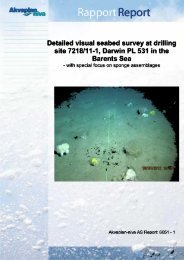A study of the priority substances of the Water Framework Directive ...
A study of the priority substances of the Water Framework Directive ...
A study of the priority substances of the Water Framework Directive ...
Create successful ePaper yourself
Turn your PDF publications into a flip-book with our unique Google optimized e-Paper software.
..:::::::::: nonylphenols<br />
..:::60<br />
24 Nonylphenols<br />
� Nonylphenol is a mixture <strong>of</strong> isomeric<br />
monoalkyl phenols, <strong>the</strong> technical grade is a mixture<br />
<strong>of</strong> 90% 4-nonylphenol and 10% 2nonylphenol.<br />
� Nonylphenol is found in <strong>the</strong> environment primarily<br />
as a biodegradation product <strong>of</strong> nonylphenol<br />
ethoxylates, and is a recognised endocrine<br />
disruptor.<br />
� Nonylphenol and nonylphenol ethoxylates<br />
should be screened in Norwegian environment.<br />
Production and use<br />
In Norway, main users have been Hydro<br />
Polymers in Porsgrunn (paste PVC) Grenland,<br />
Telemark County, Jotun in Sandefjord, Vestfold<br />
County (additives in paint) and some producers<br />
<strong>of</strong> car wash detergents. These sources have all<br />
been phased out. Nonylphenol and nonylphenol<br />
ethoxylates can be found in some imported<br />
products such as paint, car-wash detergents and<br />
plastic. The main source in 2002 was "car related<br />
products" and detergents. Consumption in<br />
2002 was set to 58 kilos. Imports and use are<br />
regulated (mainly banned) since 2002, and <strong>the</strong>re<br />
is a national target for phasing out by 2005.<br />
Nonylphenols are also used as spermicide<br />
(nonoxynol-9) on condoms and contraceptive<br />
creams.<br />
Emissions, discharges,<br />
distribution and hot-spots<br />
Nonylphenols are mainly discharged to waste<br />
water main sources have been garages and carwashing<br />
machines, but also from households.<br />
Nonylphenol ethoxylates are found in water<br />
and sludge from municipal waste water treatment<br />
plants. A survey by Aquateam from 1998<br />
showed nonylphenol (+ ethoxylates) in high<br />
concentrations in sludge samples from 8 sewage<br />
treatment plants in Norway. Concentrations<br />
were 22 - 650 mg /kilo dry matter.<br />
There are few data on environmental distribution.<br />
SFT has calculated that emissions <strong>of</strong><br />
nonylphenols have dropped from 170 tonnes in<br />
1991 to 18 tons in 2002; <strong>the</strong> sharpest drop was<br />
from 2001 to 2002. Discharges to water from<br />
products (only significant source) have dropped<br />
from appr. 184 tons to 15 tons in 2002 according<br />
to SFT. It is assumed that <strong>the</strong> chemicals are<br />
discharged via (municipal) waste water.<br />
A <strong>study</strong> <strong>of</strong> <strong>the</strong> <strong>priority</strong> <strong>substances</strong> <strong>of</strong> <strong>the</strong> <strong>Water</strong> <strong>Framework</strong> <strong>Directive</strong><br />
TA-2140/2005<br />
FACTS<br />
Cas no.: 25154-52-3<br />
Synonyms: nonylfenol, nonyl, NP, nonoxynol-9<br />
Properties: Pale-yellow, viscous liquid. (C9)<br />
Toxic effects: Nonylphenols are slightly toxic when<br />
swallowed. They are severely irritating to skin and<br />
eyes. Acute LD50 rat oral is 1 600 mg/kg.<br />
Nonylphenols are toxic to aquatic organisms; LC50<br />
Rainbow trout (Oncorhynchus mykiss) is 0,56-0,92<br />
mg/l/96 h (ClassLab/HSDB). Nonylphenols are also<br />
teratogenic, and <strong>the</strong>y are on <strong>the</strong> EU list <strong>of</strong> endocrine<br />
disruptors.<br />
Log Kow: 4,2 - 4,7<br />
Persistence: Half-life in air is estimated to 7,5 hours<br />
(hydroxyl radicals), while half life in water is 17 days<br />
(volatilization). Adsorption to suspended solids and<br />
sediments will limit volatilization; estimated volatilization<br />
half-life from a model pond is greater than 25<br />
years if adsorption is considered. Nonylphenols<br />
bioaccumulate in aquatic life forms.<br />
<strong>Water</strong> solubility: 3-11 mg/l (pH dependent).<br />
Molecular formula: C 15 -H 24 -O<br />
Metabolites: The corresponding NP-glucaronide and<br />
hydroxy conjungates.<br />
Alkylphenols (including nonylphenol) are<br />
released through discharges <strong>of</strong> "produced<br />
water" from <strong>of</strong>fshore oil producing installations.<br />
Concentrations are low, but total sum is<br />
large due to <strong>the</strong> large amount <strong>of</strong> water emitted.<br />
SFT has calculated that 23,6 tons alkylphenols<br />
(alkylchain <strong>of</strong> C4 and upwards) was discharged<br />
in 1998. According to Institute for Marine<br />
Research <strong>the</strong> discharges <strong>of</strong> nonylphenol and<br />
octylphenol from oil and gas production in <strong>the</strong><br />
Norwegian sector limited, and discharges <strong>of</strong><br />
shorter chain alkylphenols is <strong>the</strong> norm.<br />
Monitoring<br />
Nonylphenol and nonylphenol ethoxylates were<br />
investigated in a Norwegian <strong>study</strong> in 1997.<br />
Marine sediment<br />
The <strong>study</strong> in 1997 has shown low concentrations<br />
<strong>of</strong> nonylphenol and nonylphenol ethoxylates<br />
in several fjords in Akershus, Østfold,<br />
Telemark and Hordaland. Concentrations were

















